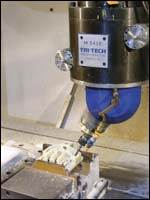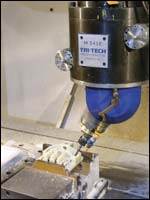An Overview Of 3+2 Machining
An introduction to 3+2 machining: how it works and what it can do for your machine shop.
3+2 machining is a technique whereby a three-axis milling program is executed with the cutting tool locked in a tilted position using the 5-axis machine’s two rotational axes, hence the name, 3+2 machining. It is also called “positional 5-axis machining” because the fourth and fifth axes are used to orient the cutting tool in a fixed position rather than to manipulate the tool continuously during the machining process. This distinguishes 3+2 machining from continuous or simultaneous 5-axis machining. Other names that appear are inclined, fixed or tilted machining, in reference to the characteristic angle of the cutting tool.
The main advantage of 3+2 machining is that it allows for the use of a shorter, more rigid cutting tool than would be permissible with conventional three-axis machining. With 3+2, the spindle head can be lowered closer to the workpiece with the tool angled toward the surface. Using a shorter tool, in turn, permits faster feeds and speeds with less tool deflection. This means that a good surface finish and more accurate dimensional results can be achieved at a lower cycle time. Other benefits include shorter tool movements, fewer lines of program code and fewer machine setups.
Any workpiece that creates challenging cutting conditions when using simultaneous 5-axis machining ought to be considered a candidate for 3+2 machining.
This technique is growing in popularity with mold shops because it helps with deep cavities in complex molds that would otherwise have to be machined with long, slender tools or with tool extensions. Long, slender tools increase the risk of deflection or chatter and tool extensions can create clearance problems. Using 3+2 machining also allows undercuts in cavities and steep walls on standing mold cores to be machined directly. This strategy might reduce or eliminate operations for electrical discharge machining (EDM).
Of course, applications are not limited to die/mold machining. Any workpiece that creates challenging cutting conditions when using simultaneous 5-axis machining ought to be considered a candidate for 3+2 machining. One example is tube machining. Curved or angled tube shapes within a workpiece such as ports on a cylinder head or ducts on a valve body often can be machined effectively with 3+2 if the CAM software supports this application. In addition, 3+2 can help with machining certain types of parts from the solid rather than from a complex casting. Prototype work also benefits from this technique.
Drilling holes at compound angles in a single setup is also an important benefit to 3+2 machining. Aligning the drill at the correct orientation is accomplished in programming rather than on the shop floor with multiple setups and complex fixturing.
Strategizing for 3+2 Machining by Thinking Three-Axis
One way to think about 3+2 machining is to visualize how selected workpiece features could be machined on a three-axis VMC if the difficult features fell in the most convenient workplane for effective three-axis machining. In some cases, a workpiece could be positioned on a special fixture or sine plate for three-axis machining at the right orientation; however, 3+2 uses the angle of the cutting tool’s fixed position to create the same relative alignment. This is accomplished by creating a virtual workplane that locates the workpiece features so that the angled tool executing the three-axis program has the desired effect. The CAM software makes all of the transformations in the coordinate system to produce these results.
The smart thing about 3+2 machining is that workplanes can be established for multiple machining regions on the same workpiece. The user can select these regions wherever 3+2 is beneficial and practical, without refixturing the workpiece. Machining undercuts in opposite sides of a cavity is an example.
The 3+2 machining operations can occur in succession, with the cutting tool reset at the appropriate angle between operations. (For this reason, this technique has been called “index machining” in some contexts.) The one drawback to indexing is that blends between surfaces created at different tool angles have to be examined carefully to be sure that the desired effect is produced. Blending issues appear to be a function of programming software and its level of development.
CAM Software for 3+2 Machining
A number of CAM software suppliers have developed special utilities to create tool paths for 3+2 machining. Not all 5-axis programming software includes provisions for this technique. Like all software capabilities, ease of use and effectiveness of 3+2 machining utilities vary from software package to software package.
CAM suppliers that specialize in software especially for moldmaking are likely to include 3+2 machining as a product feature in their 5-axis machining offerings. Because there is no standard terminology to describe this technique, there might be a tendency to overlook this capability when reviewing CAM software features. In one case, the feature is listed as part of a machining strategies library, and it is described as “5-axis tilting for machining deep cavities with short tools.”
Potential users of 3+2 machining should evaluate the collision avoidance and program simulation capabilities of the CAM software being considered.
Utilities for 3+2 machining also vary according to the level of automation available to facilitate the programming function. Establishing the workplane and machining zones; setting travel limits for cutting tool motion; and controlling the tool angle are some of the steps that might be more or less automated, depending on the system. Automatic definition of the approach and retract movements between machining zones is a capability of some systems.
Almost all CAM software suppliers that offer 3+2 machining for 5-axis machines emphasize the importance of effective collision avoidance. Although 3+2 machining simplifies tool motions because it is essentially three-axis machining with no “twists and turns” of the spindle head to maneuver the cutting tool, it is not without risk. Potential users should evaluate the collision avoidance and program simulation capabilities of the CAM software being considered.
In general, programming for 3+2 is not an obstacle. As a matter of fact, the power of available programming utilities for 3+2 machining is one reason why this technique is catching on.
3+2 Machining Is a Complement to Full 5-Axis
As a handy technique, 3+2 machining is one of the options that makes a 5-axis machining center a valuable asset. However, it is not a substitute for simultaneous 5-axis machining. For example, simultaneous 5-axis is needed to use a flat-nosed end mill for producing sharp corners in cavities. Three + 2 machining generally uses a ballnosed end mill as you would with three-axis machining on a conventional three-axis machining center. Other cutting modes that use cutting tools with conic, lollipop or other special geometries may require full 5-axis motion to optimize results.
Where applicable, 3+2 machining will save time and improve operations. On the other hand, workpieces don’t have to be strictly “5-axis jobs” to make a 5-axis machine worthwhile and profitable.
In some cases, using 3+2 machining to perform roughing operations followed by simultaneous 5-axis machining for finishing operations is recommended. For roughing, the shorter tool length allowed by 3+2 lends itself to aggressive high speed machining techniques. Rest machining (going back with a smaller cutter to “clean up” material left by roughing operations with a larger tool) can be effectively accomplished with 3+2 in many cases.
For some shops, 3+2 machining eases the transition from three-axis milling to simultaneous 5-axis machining. Milling with fixed tool positions builds positive experiences that can be drawn on for 5-axis machining. As one software supplier has noted, moving from one fixed tool position to another in succession is just a short step away from the continuous motion of simultaneous 5-axis machining.
More 5-Axis Machines in Shops
In the last decade or so, 5-axis machines have become smaller and more affordable than they once were. At the same time, programming software for 5-axis work has become more powerful, easier to use and lower in price. These trends have promoted the growing use of 5-axis machines for die/mold work, medical parts, prototyping and other applications that involve increasingly complex geometries and tight surface quality requirements.
Any shop that is considering a move to 5-axis machining should be aware of 3+2 machining as an option to enlarge what a 5-axis machine can do. Where applicable, 3+2 machining will save time and improve operations. Workpieces don’t have to be strictly “5-axis jobs” to make having a 5-axis machine worthwhile and profitable.
Related Content
In Moldmaking, Mantle Process Addresses Lead Time and Talent Pool
A new process delivered through what looks like a standard machining center promises to streamline machining of injection mold cores and cavities and even answer the declining availability of toolmakers.
Read MoreStars Slowly Align for Small Shop Merger
RPM Tool’s seemingly overnight expansion from a five-person machine shop to an almost 30-employee production business involved over a year and a half of planning.
Read MoreGrob Systems Inc. to Host Tech Event With Industry Partners
The 5-Axis Live technology event will highlight new machining strategies for optimizing the production of complex medical, aerospace and mold/die parts.
Read MoreYCM Alliance Hits IMTS
YCM Technology has joined with other like-minded machine tool manufacturers to take a solutions-based approach to manufacturing.
Read MoreRead Next
Programmable Head Brings Five-Axis Machining To Three-Axis VMC
Having no prior experience with five-axis machining, this shop had two options: incur the hefty expense of purchasing a true five-axis machining center or explore less costly alternatives.
Read More3 Mistakes That Cause CNC Programs to Fail
Despite enhancements to manufacturing technology, there are still issues today that can cause programs to fail. These failures can cause lost time, scrapped parts, damaged machines and even injured operators.
Read MoreThe Cut Scene: The Finer Details of Large-Format Machining
Small details and features can have an outsized impact on large parts, such as Barbco’s collapsible utility drill head.
Read More








.jpg;maxWidth=300;quality=90)





















.jpg;maxWidth=970;quality=90)